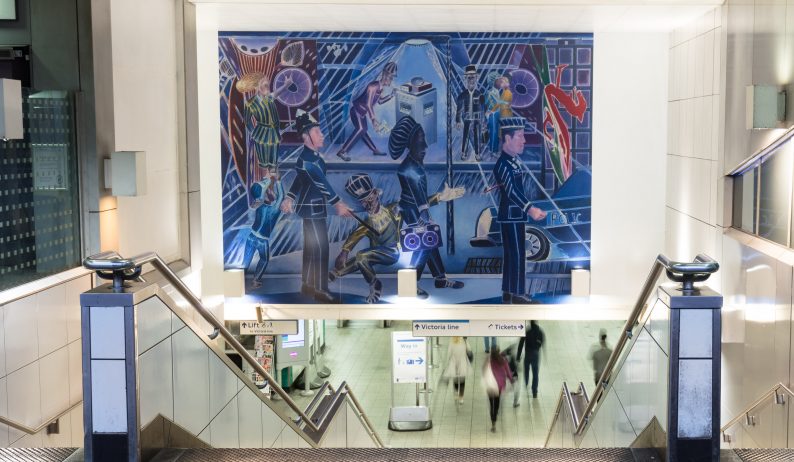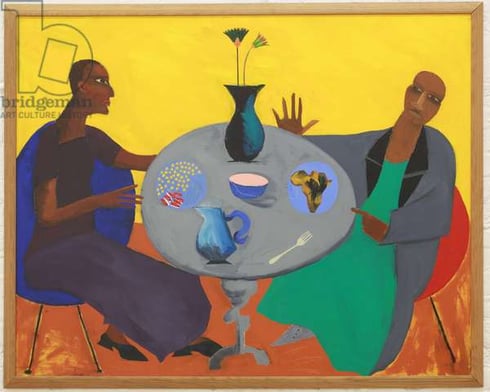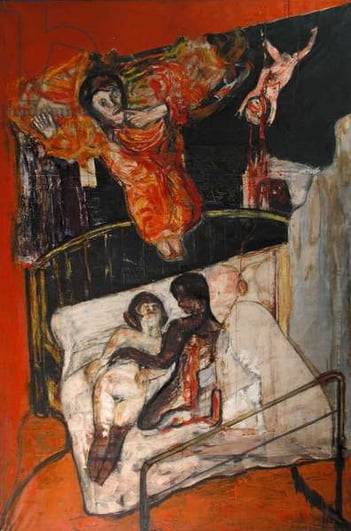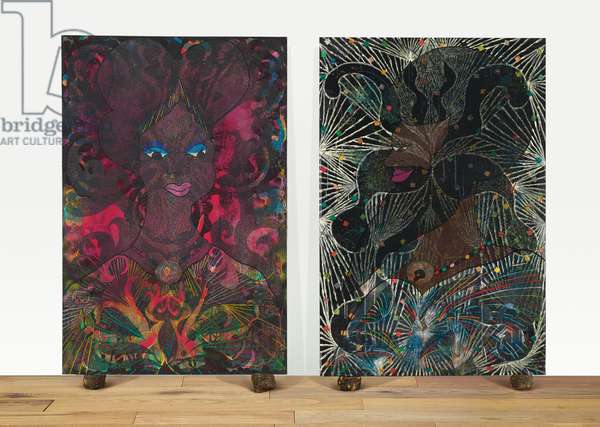Black History Month: 10 Great Contemporary Artists
This October, Bridgeman Images takes a look at some of the most interesting and influential black artists from the UK and the US.
Black artists have consistently provided high-quality and thought-provoking work, today’s contemporary artists being no exception. This list is by no means exhaustive, and Bridgeman Images would like to encourage everyone to go and find out more for themselves, and enjoy the diverse range of art on show today.

Forrester was born in Grenada in 1956, and came to England at the age of ten, later completing his BA at the Central School of Art; his MA at the Royal College here. He won the Rome Scholarship in 1983, followed by the Harkness Scholarship which took him to New York for eighteen months. The urban life of London is Forrester’s main source of inspiration from which he has produced large-scale, colourful paintings. The music of the West Indies has also affected his work, whilst his time spent in Italy has informed his colour palette. Recently he has been commissioned by TfL to create a large-scale public artwork for Brixton station, which is on view now until until September 2020. For his first major UK public commission, Forrester has reinterpreted his work ‘Three Wicked Men’ (1982), identifying the three men as a policeman, a politician and a businessman.

© Yinka Shonibare CBE Courtesy the artist, Stephen Friedman Gallery (London) and James Cohan Gallery (New York). Photography courtesy Stephen White
Yinka Shonibare MBE left London a child but later returned to study Fine Art at Central Saint Martins and then at Goldsmiths College, receiving his MFA. Shonibare’s work explores issues of race and class through the media of painting, sculpture, photography and film. His dual identity as British-Nigerian has been the impetus of many of his works, questioning the meaning of cultural and national definitions. He often incorporates African batik fabric into his work. In January 2019, Shonibare was awarded the decoration of CBE. One of his most famous works is ‘Nelson’s Ship in a Bottle’ commissioned for the Fourth Plinth in Trafalgar Square in 2010. The work raised issues regarding the role of empire and British colonialism, the sails being made of his signature choice batik fabric.

Lubaina Himid is the 2017 Turner Prize winner and Professor of Contemporary Art at the University of Central Lancashire. Himid was born in 1954 in Zanzibar, Tanzania. She studied Theatre Design at Wimbledon College of Art and an MA in Cultural History at the Royal College of Art. She works with painting, printing, drawing and installation which is said to combine satire and theatricality. She uncompromisingly addresses the history of slavery and colonialism, and institutional visibility for people of colour, but also celebrates black creativity and the African diaspora.

No list would be complete with Basquiat. Jean-Michel Basquiat was a Neo-Expressionist painter in the 1980s. He has an unmistakable style which is raw, graffiti-like and highly expressive. He began graffitiing when he lived on the streets at the age of 17. At the age of 20 he participated in his first formal art exhibition, The Times Square Show (1980). During the ‘80s there was a resurgence of Expressionist painting, with Basquiat’s work also being highly gestural and intuitive. Whilst much of his work dealt with personal emotion and self-portraiture, it also referenced African-American culture and figures, and African and Aztec motifs. The ’80s saw Basquiat develop a signature motif: a heroic, crowned black oracle figure. His enduring legacy demonstrates the power of his imagery that was developed during his short life.

Bowling was born in 1934, in Bartica, colonial British Guiana. In May 1953, aged 19, Bowling came to London and between 1957 and 1959 he studied at Regents Street Polytechnic, Chelsea School of Art and the City and Guilds of London Art School; before winning a scholarship to the Royal College of Art to study painting. Bowling was elected as a Royal Academician on 25 May 2005, the first black artist to be awarded the accolade. Three years later, in 2008, he was awarded the Order of the British Empire (OBE) for services to art and became a senior Royal Academician on 1 October 2011.

Ringgold was born in 1930 in Harlem, New York. From the 1970’s Ringgold left traditional painting, to develop a new style using unstretched canvas and elaborate fabric borders. These grew to become her famous quilt-sized paintings which she made with her mother. The collaborative nature of the quilts emphasise the importance of family, roots, and artistic collaboration, whilst the act of quilt-making, traditionally a female and domestic pursuit, rejects the distinctions between fine art and craft. In late 60s, Ringgold demonstrated against the exclusion of black and female artists by New York’s Whitney Museum of American Art and the Museum of Modern Art and in 1971 co-founded Where We At, a group for African-American female artist. Today, she is a renowned author, artist, teacher and activist.

Lynette Yiadom-Boakye is a London based artist who is considered to be one of the most influential painters of her generation, and one of the most successful Black-British artists today. Her work is best known for her portraiture of fictitious subjects, which she creates by combining elements of various real-life people she has seen. Her compositions often allude to canonical European portraiture, but her form and technique are contemporary. She often explores issues of identity and representation and her work is credited with reigniting the subject of the black figure. Next year, the Tate will hold the first major exhibition of her work, bringing together over 80 of her paintings for the first time.
Lynette Yiadom-Boakye, 19th May – 31st August 2020, Tate Britain, London.

Chris Ofili (b.1968) is a British Turner Prize-winning painter. He is best-known for his works incorporating elephant dung, including the Turner Prize winning, No Woman, No Cry (1998). He studied at the Chelsea School of Art (1988–91) and the Royal College of Art (1991–3). Ofili travelled to Zimbabwe after winning a scholarship in 1992 which informed his subsequent approach to painting. Ofili applies elephant dung directly to the canvas or as a support for the work itself, an act that disturbs and rejects Eurocentric standards of fine art. Both his technique and subject matter explore and celebrate issues of the black experience and identity. His works are celebrated for their decorative qualities and political complexity.
View this post on InstagramA post shared by Zak Ové (@zakove) on
Zak Ové (b. 1966) is a London based multi-disciplinary artist working in film, sculpture and photography. He graduated in 1987 from St. Martin’s School of Art with a Film as Fine Art BA. His work is inspired by traditional Trinidadian carnival and ritual masks. He transforms ancient ritual with modern materials and technique to reinvigorate lost culture. There is also an element of play and parody, but by placing his work amongst European architecture Ové also exposes the ways in which Trinidadian culture has endured a colonial past, to live on today. Most recently, Ové has curated Get Up, Stand Up Now’ this year at London’s Somerset House.

Tantra is a British artist of Balinese decent and was born in New York in 1979. She studied at the Slade School of Fine Art, University College London 1999-2003 and at the Royal Academy Schools London 2004-06. In 2017 she was the first person to have been awarded the Bridget Riley Drawing Fellowship at The British School at Rome (2017). Tantra’s work is known for her site-specific murals, large installations, vast architectural projects, and a bold graphic aesthetic. Sintra has spoken of her interest in the semiotics of colour, and the ways in which colour can reflect identity and the subconscious. The contrast between hot pink and blue have frequently featured in her work.

This year, we are very fortunate to have Zak Ové and Sintra Tantra judging the Bridgeman Studio Award. Launching on the 5th of October 2019 to celebrate Black History month in the UK and promoting the Art of Diversity, the international Bridgeman Studio Award is sponsored this year by Verizon Media.
So, how do you see and experience diversity in your city?
Enter the Bridgeman Studio Award Website
Learn More about the competition theme
Get in touch if you have any questions.
We can’t wait to see your entries!

